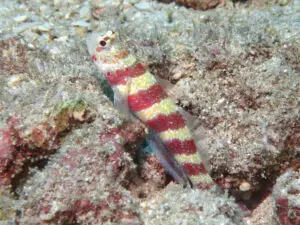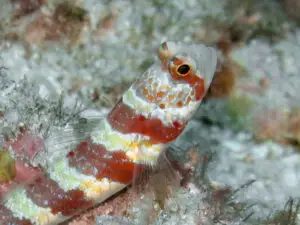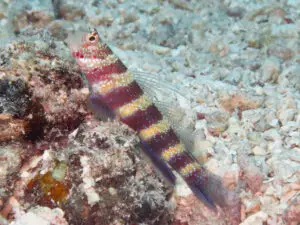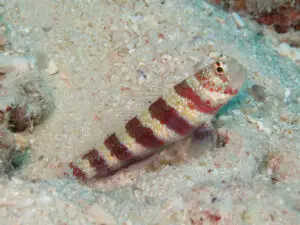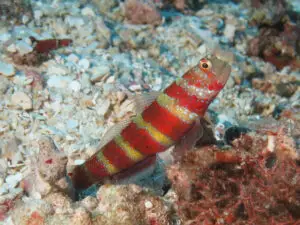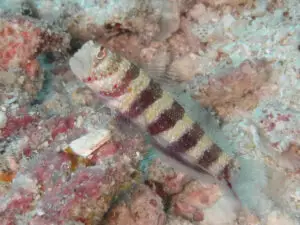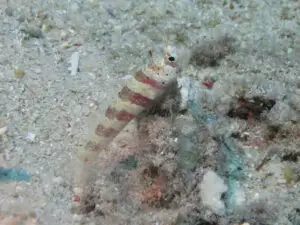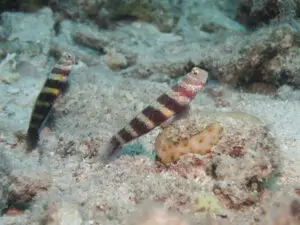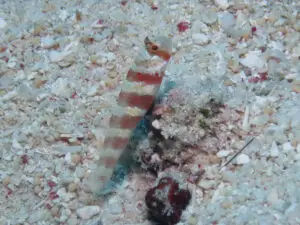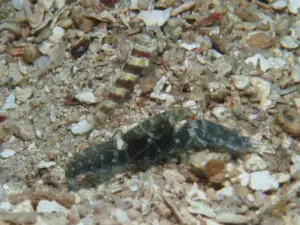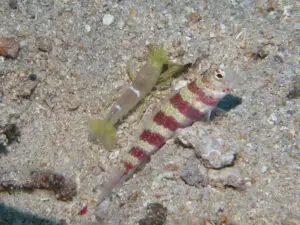Burgundy Shrimpgoby
Amblyeleotris wheeleri
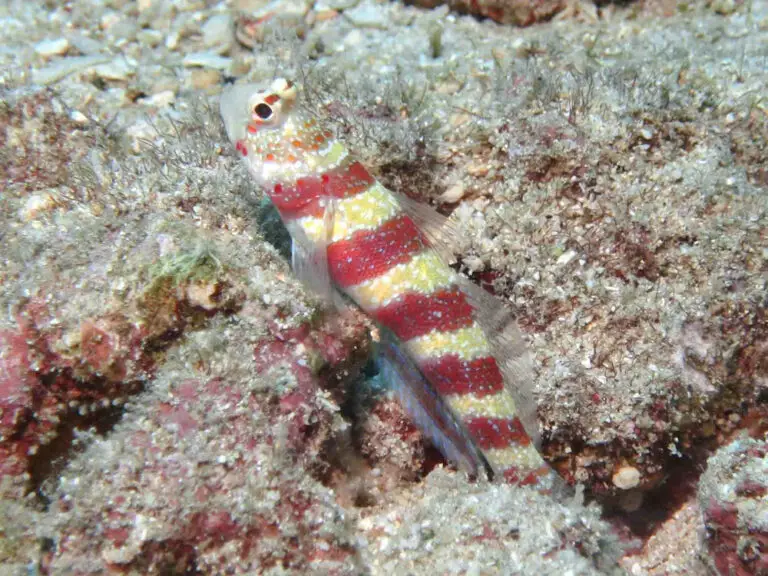
Burgundy Shrimpgoby
Amblyeleotris wheeleri
(Polunin and Lubbock, 1977)
Description
Body design
This is a medium sized goby, around 10 cm in length, marked with six dark red bars with equal, or slightly narrower yellowish bands between them.
Head design
A band of red spots over the gill cover runs forward to join a red bar below the eye. This may be dense enough to resemble a seventh body bar. There are red spots on the head and blue spots over the head and remainder of the body.
The head is pale grey forward of the first yellow bar. Immediately forward of this are two rows of white bordered red spots. There is a vertical red line below the eye.
Fin design
The first dorsal fin is translucent, triangular and has extended rays, the third being the longest. The second dorsal fin is translucent with fine stippled markings. The pectoral fin is translucent. There are a small number of white margined red spots scattered over both. There is a blue edged red stripe running through the pelvic fin, then continuing through the the anal fin, and the ventral aspect of the caudal fin.
Diagnostic features
The combination of markings is unlike that of any other shrimpgoby.
Deep water Variation
A widespread colony of A wheeleri living on an outer reef shelf at Ribbon Reef 3, on the Great Barrier Reef at 30 metres differs in being dark red with narrow yellow bands, rather than having the two colour bands of equal width.
Similar species
A distinctive species that looks different from any of the banded species even at a distance
Taxonomy.
Other common names: Gorgeous Shrimpgoby, Red Barred Shrimp Goby, Wheeler’s Shrimpgoby
Randall (2005) calls this fish A. fasciata states that A. wheeleri is a synonym.
Type description Cryptocentris wheeleri Polunin and Lubbock 1977 J. Zool. London 183: 88.
Type locality Aldabra Island, Seychelles.
Natural History
Habitat
The preferred habitat is sand patches on the fringing reef slope. They particularly favour strip-like sand patches among shallow rocky reefs, around 5 to 10 metres but can be found at 40m
The habitat is often comprised of pink coralline alga encrusted coral pebbles and short algal tufts making a complex pattern.
Though this is the usual habitat we have also seen them at 30 m on sand with parallel rows of algae-covered coral rock fragments on the outer side of Ribbon Reef 3.
We have also found them on the front reef at Lady Musgrave Island in discontinuous grooves through the healthy hard coral. The substrate here is made up of coarse sand grit devoid of fine particles and far from ideal for making tunnels. Burrows were wide-mouthed funnels with vertical entrances.
Behaviour
Characteristically keeps a lookout perched almost vertically on the side of a suitable rock, darting off from time to time to catch some small creature seen moving through the sand and rubble.
Burrows are on sandy patches among rocks more often than on open or exposed sand.
Distribution
Published Distribution:
Red Sea and East Africa to Islands of Micronesia. North West Australia. East coast of Australia from the northern Great Barrier Reef to Sydney, and Lord Howe Island. Western Pacific from the Ryukyu Islands to New Caledonia
Our records:
Solomon Islands; Gizo Island, Russell Islands and Kolombangara.
Vanuatu; Ambae Island
Australia; Great Barrier Reef from Lizard Island to Lady Musgrave Island, specifically Lizard Island, Ribbon Reefs 3 and 10, Flynn Reef, Whitsunday outer reefs and North West Island.
Associated Shrimp species
Associated Shrimps (two shrimps)
Dark Marbled Snapping Shrimp, Alpheus macellarius
Yellow Pyjama Snapping Shrimp, Alpheus ochrostriatus
Videos (to be added)
We have videos showing the following behaviour:
Goby catching food and returning to burrow swimming backwards by use of pectoral fins
Shrimps doing ‘‘make believe’ work but more interested in exploring and finding algae
Shrimps holding alga with plain claw and carefully snipping off pieces with cutting claw.
Goby losing patience with two prawns climbing all over it, and putting them emphatically back into the burrow.

